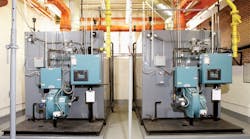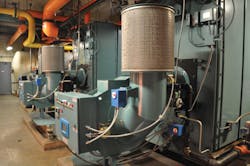The burner is the true driver of fuel use and costs in a boiler. Over time, linkage joints, cams, and other moving parts wear out, and a burner loses its ability to keep tight control of fuel/air ratio. The result commonly is referred to as “hysteresis,” or the inability of a burner to repeat desired excess-air levels across the firing range for optimum combustion. Higher excess air means lower combustion efficiency. Additionally, a legacy burner can suffer from plugged or deteriorated nozzles and gas orifices, deterioration of other combustion-head components responsible for proper fuel and air mixing, and a host of other issues. All of this results in unburned fuel and higher-than-required excess-air levels, leading to poor performance, reduction in overall efficiency, and higher operating costs.
If a burner has too many worn-out parts or outmoded technology, the optimum solution is not new controls, but replacement with a new burner featuring advanced controls, higher turndown capability, and lower excess-air requirements. Depending on a variety of factors unique to a boiler system, replacing an old burner can reduce fuel use by 5 to 10 percent.
Retrofit Reduces Costs by 30 Percent
Part of the Episcopal Senior Communities network, St. Paul’s Towers in Oakland, Calif., is a 213-room senior-living community requiring heat and hot water 24 hours a day, seven days a week. To accommodate this need, St. Paul’s Towers counts on two gas-fired, flextube hot-water boilers, each with an input of 6.0 MMBtuh. With new state regulations mandating that boilers emit less than 15-ppm nitrogen oxide (NOx), St. Paul’s Towers contacted its boiler-service provider, R.F. MacDonald Co. of Hayward, Calif., about an equipment upgrade.
After analyzing the equipment and reviewing the emissions requirements, St. Paul’s Towers retrofitted its boilers with Cleaver-Brooks ProFire MTH Series burners. ProFire MTH burners incorporate premix, surface-burning technology for ultralow-NOx-emissions performance. They are fitted for full modulation with parallel positioning control and offer both low NOx and low carbon-monoxide emissions without flue-gas recirculation. These boiler-burner packages also include automatic adjustment for proper water temperature under changing conditions, as well as network connectivity for remote operation and control.
The two new MTH burners were installed in less than one week without service to residents being interrupted. Immediately following the installation, Facility Manager Bob Reagan noted an increase in energy efficiency. In fact, the new burners were optimized so effectively that under normal conditions, only one of the two boilers typically is needed to supply hot water for the building. As a result, the gas bill at St. Paul’s Towers decreased by 30 percent. Before the burner retrofits, gas bills were approximately $38,000 per month. Today, they are less than $26,000 per month.
In addition to saving a significant amount of money in fuel costs, the burners more than met the 15-ppm NOx requirement set forth by the Bay Area Air Quality Management District. NOx emissions were reduced to single-digit levels.
Retrofit Helps to Meet NOx Requirement
In 2005, the San Joaquin Valley (Calif.) Air Pollution Control District (APCD) set a NOx-emissions limit of 9 ppm. Working with R.F. MacDonald Co. of Modesto, Calif., a large cereal manufacturer installed Cleaver-Brooks NTI low-emissions burners on its two Cleaver-Brooks CBLE 700-hp firetube units.
“In the area meetings, APCD said 9 ppm was as low as they were going to go,” Bob Murr, senior project engineer for the cereal manufacturer, said.
But in 2010, environmental conditions caused the APCD to tighten its NOx requirement to 7 ppm. R.F. MacDonald recommended installation of a Cleaver-Brooks 7-ppm retrofit kit and an integrated programmable-logic-controller-based Hawk touchscreen control panel on both CBLE units.
The boiler-system upgrade was performed during a scheduled plant shutdown in June 2010. Since then, the cereal manufacturer has been achieving sub-7-ppm NOx.
When a Burner Retrofit Makes Sense
While a boiler and other components can withstand the rigors of constant service for decades, burners need to be upgraded. The practical life of a burner is 10 to 20 years, depending on the type of load (modulating/non-modulating) and site conditions.
Most older burners and many new ones operate on the high/low/off principle, with single-point positioning systems. This provides little adjustability and, in time, poor fuel/air-ratio control, meaning considerable boiler cycling and high excess air or sooting. Today’s burners have high turndown capability and parallel positioning, allowing a boiler to modulate to better match the needs of the load while precisely tracking fuel/air ratio, mitigating energy waste.
For Design Solutions author guidelines, call Scott Arnold, executive editor, at 216-931-9980, or write to him at [email protected].










